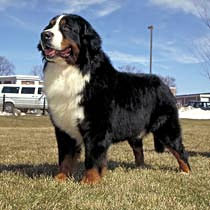|
The Canine Chronicles Directory
Bernese Mountain Dog

Bernese Mountain Dogs are strong dogs with a sturdy build and tremendous power.
They have a moderately long weather-resistant coat with a silky soft outer coat
and a thick under coat. They are tri-colored with markings of rust and white. White
coloring is usually on the chest, head and toes and the rusting on the eyes, cheeks,
under the tail, the sides of the chest and on each leg. The broad head is strong
with a flat skull. They have a slightly furrowed but well defined stop. The jaw
is strong and the teeth should have a scissor-like bite. The almond shaped eyes
should be dark brown in color and the nose black. The triangular shaped ears are
medium size and set high on the head. Bernese Mountain Dogs have a wide, deep chest
with a firm, straight back. The muscular neck is medium in length merging into strong
sloping shoulders. The front legs should be straight and the hindquarters broad
with well-bent stifles. Feet should be short, round and the tail, bushy reaching
below the hocks.
|
|
Temperament
|
Bernese Mountain Dogs are gentle, loyal, self-confident, affectionate and good natured.
They love to be included in all aspects of family life and are very good with children.
They do not acclimate very well to being alone. They also have a hard time adjusting
to new owners when older than 18 months. Bernese Mountain Dogs get along with non-canine
pets as long as they are well socialized while they are still young. Some can become
dominant towards other dogs; however, socialization will also help with this issue.
This breed has a slow maturity rate and may remain puppy-like for an extended period
of time.
|
|
Height, Weight
|
Male Height: 24-28" ; Weight: 85-110 lbs.
Female Height: 23-27" ; Weight: 80-105 lbs.
|
|
Health Problems
|
This breed's major health concern is cancer. Berneses' can succumb to cancer at
a very young age. Some minor problems can include bloat, eyelid problems and elbow
and hip dysplasia.
|
|
Living Conditions
|
Berneses should not live in an apartment. They do best with a medium to large yard.
They enjoy a cooler climate and can become uncomfortable during warmer weather.
|
|
Exercise
|
Berneses are a working bred and need lots of exercise.
|
|
Life Expectancy
|
About 6-8 years due to cancer concerns
|
|
Grooming
|
The coat of this breed needs to be brushed daily to weekly. This breed is a seasonal
heavy shedder.
|
|
Origin
|
The Bernese Mountain Dog's origin can be traced back to when the Romans invaded
Switzerland. Two thousand years ago, this area was known as Helvetia. The dogs were
used as cattle drovers and guard dogs. The Bernese Mountain Dog was probably developed
by crossing roman mastiff-type dogs with flock-guarding dogs that were known for
their softer tempers and their survival rate in the Alps Mountains. These dogs were
used as cart-pullers to transport goods and services to and from surrounding villages.
In the 1800s this breed was close to extinction due to the interest toward other
breeds like the St. Bernard and the lack of concentrated breeders. At the turn of
the 20th Century a Swiss Cynologist, Herr Franz Schertenlieb found remnants of the
breed, mainly in the Durrback district of Berne. He eventually teamed up with Albert
Hiem, a Zurich professor. Due to their dedication to this breed, they have begun
to increase in size. The Bernese Mountain Dog was named after the Berne canton of
Switzerland where the breed is widely known. By 1908, the Bernese Mountain Dog had
a huge following in Switzerland, Scandinavia and on the Continent. This breed was
finally recognized by the AKC in 1936. They are also recognized by the UKC.
|
|
Group
|
AKC Working, UKC Guardian Dog
|